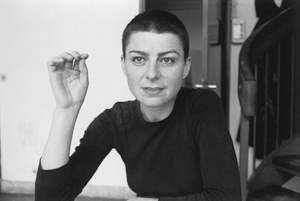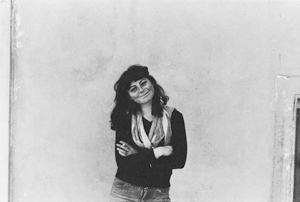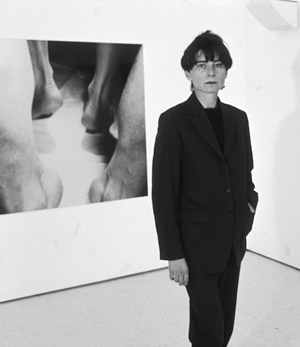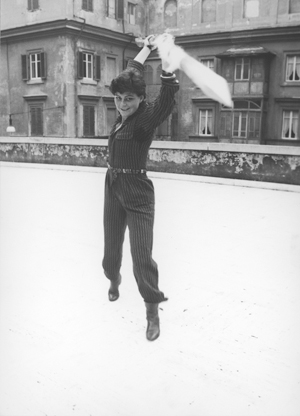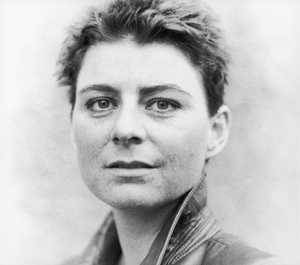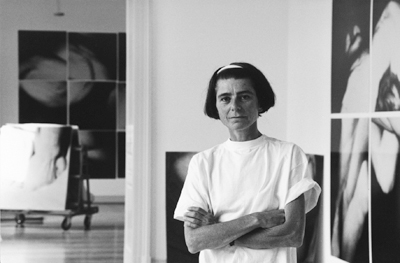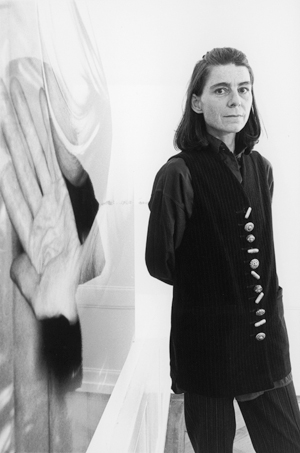“1/Fragment of a Portrait, perhaps”*
* December 9, 1951 in Cham, Canton Zug/Switzerland
† August 12, 1997 in Auw, Canton Aargau/Switzerland
1951
December 9 Johanna Franziska Villiger is the fourth of five children of Adolf Villiger and Margrit Villiger-Laubacher.
1967 - 1970
Cantonal commercial school at the Cantonal School Zug, graduation with a degree in commerce. Designs capricious pieces of clothing which she is able to sell in a boutique in Zug. She retains her love of striking clothing throughout her life.
1970
Works as temporary help in a Zurich advertising agency.
Beginning in autumn Six months of language instruction in Cambridge/UK.
1971
April Begins a year-long preliminary course at the School of Applied Arts, Zurich.
December Exhibits photographs of Berlin in the exhibition Zuger Maler, Plastiker und Fotografen.
1972
April ”Art is not a profession but rather a path to truth and self-realization, not only for the artist but also for the observer.” Start of two years of training at the School of Applied Arts at Lucerne in the class on sculptural form taught by Anton Egloff.
Autumn Leaves the home of her parents, rents a house together with friends in Uerzlikon near Zurich.
1974
February Before completing her studies she is also awarded a first art scholarship by the Swiss Confederation as well as a grant for a two-year residence at the Istituto Svizzero in Rome. First solo exhibition in Zug with objects, drawings and etchings: ”All in all, the images which Hanni Villiger displays at Balmer’s are fragments, intimations of an intense encounter with objects. It is in any case worthwhile to experience this encounter.” (Review [roc] 1974).
May – October After completing her training, spends six months in Canada and the USA. She works outside, removes bark from tree trunks, discovers and works with various materials: ”shed one’s skin … shed the skin of another … shed the skin of an object.” Exhibition together with Jürg Stäuble in Toronto.
Beginning in November Residence at the Istituto Svizzero in Rome. Intense encounter on a personal and artistic level with the other fellows at the Institute, with Arte Povera and with the Roman art scene.
1975
Creation of large sculptural objects, spears and lances from organic materials: ”A warrior needs weapons.”
June Participation in the 6. Schweizer Plastikausstellung in Biel as one of the youngest artists.
Summer Makes the acquaintance of Susan Wyss; beginning of an intense and conflict ridden relationship.
September Together with Helmut Federle, John Armleder, Martin Disler, Luciano Castelli and others as the Swiss representation at the 9e Biennale de Paris.
1976
January Receives two scholarships which allow her to remain for another year in Italy.
Summer Her residence at the Istituto Svizzero in Rome comes to an end. She rents an apartment in Rome at the end of September and afterwards one in Montefalco/Umbria. Resides alternately in Rome, Montefalco and Switzerland.
October Solo exhibition at the Galerie Atelier Milchstrasse in Freiburg i. B./Germany with objects and photographs.
1977
August ”On the viewfinder of my camera— the feeling of ‘I’ with the object.”
September Returns to Switzerland and rents an apartment in Basel; works as a waitress in various bars and restaurants; has difficulties getting established in Basel.
November Solo exhibition at the Galerie Arte Arena (today Galerie Bob Gysin, Zurich) with works created the previous summer in Montefalco; photographs of an irrigation cannon, drawings and objects.
1978
Regularly shows new works in group exhibi-tions in Switzerland: ”fly away, be spit out—lift off, survive.”
Frequent travel: Basel, Cologne, Amsterdam but also Montefalco again.
February ”Between Handke Godart [sic] and Miles Davis.”
From September Rents for approximately two years a studio on Efringerstrasse in Basel. It is the only studio she ever rents, used solely as a working space.
October Solo exhibition in Wiesbaden/ Germany, a sort of retrospective of the photographs and objects created since 1975. Sells a single work to the owner of the gallery.
1979
Supports herself as a waitress, takes photographs and works with objects out of wood and plexiglass.
August – October Travels through the USA: Los Angeles – San Francisco – Oakland – Berkeley – Grand Canyon – Texas – New York.
December Shows only photographs at the Galerie Jörg Stummer in Zurich. Continues to work in her studio, however, on objects and installations. Beneath the photo of an object made from a ceiling lath she writes: ”I made two objects that corresponded to my physical feeling and to my soul. When they were finished, I took pictures of them. Now the photographs please me more.”
1980
February – March Becomes infected with acute tuberculosis and spends a month in isolation at the Basel Cantonal Hospital. ”An intense time much emptiness.” Her hospital room becomes a studio. She creates small wooden objects, Polaroid photographs and workbooks. She draws directly onto the walls of the hospital room.
April Several weeks spent in recuperation at the Basel High Altitude Clinic in Davos; works here intensively as well.
May – June Spends several weeks at the vacation home of her mother in Loco in Canton Ticino.
July – August Participates in spite of her poor health in four group exhibitions and has her own room in each of them. In Lugano she exhibits objects for the last time; otherwise she displays large-format photographic works, for the first time walldrawings and small Polaroids.
September Further medical examinations at the Tiefenau Hospital in Bern.
November Exhibits for the first time enlarged Polaroid photographs (100 x 100 cm) mounted on aluminum at the Aargauer Kunsthaus Aarau. ”Not photos these are real pictures (independent).”
1981
January Jean-Christophe Ammann, since 1978 director of the Kunsthalle Basel, exhibits local artists for the first time. Six artists have one room each to stage their works and design their own catalogues. Villiger hangs alongside each other twelve Polaroid photographs mounted on aluminum.
March Presents the same panels in a group exhibition in Regensburg/Germany as a twelve-part, wall-covering work, as a ”block.”
April 1981 – December 1982 Trip around the world with Susan Wyss: Indonesia – Australia – Fiji Islands – Hawaii – Los Angeles – Mexico.
Summer Sends Polaroid works from Indonesia to Switzerland to apply (unsuccessfully) for an art scholarship of the Swiss Confederation.
November – March Five months in Australia; preparation of an exhibition together with Susan Wyss in Sydney. ”My face twitches in misery. So once again I’m going to wander through the streets … It hits me so hard, often, it is so god-awfully empty and so superficial, that is terribly apparent to me here and I hate it. I seem to myself to be the wall of a dam, I have to pull myself together, if not I will drown … We are putting on an exhibition on January 30, the Polas are being enlarged. They are almost without an exception green + black …”
1982
ca. April – December Nine months in Los Angeles: ”Half-at-home here.” Works almost exclusively with the Polaroid camera. Tries unsuccessfully to establish contacts to galleries in New York.
December Returns to Switzerland. Susan Wyss follows a few weeks later; soon thereafter they split.
1983
First enlarged Polaroid work with the title Skulptural (Sculptural).
June Moves into a single-room apartment on the sixth floor on St. Johanns-Platz in Basel.
ca. October Begins to use her own body and the view from the rooftop terrace as the main motifs of her artistic work. Comes to agreement with Jean-Christophe Ammann concerning an individual exhibition at the Kunsthalle Basel.
1984
Concentrates her work upon an exhibition at the Kunsthalle Basel in May 1985 and a parallel exhibition at the newly opened gallery of Susan Wyss. Friendship and artistic encounters with Rémy Zaugg, Bettina Marbach, Alex Silber, Jacques Herzog, Guido Berger, Rut Himmelsbach, Silvia Bächli and others.
1985
May Shows in the solo exhibition at the Kunsthalle Basel Polaroid photographs of her body mounted on aluminum. All works are now as a rule 125 x 123 cm or 123 x 125 cm in size: ”Photos must be large so that I can get inside them. Just as if photographing with an objective.” At the time of the exhibition Neid (Envy) is published, an artist’s book in an edition of 600 copies. She pastes in 42 unbound color pictures in random sequence.
1986
January Solo exhibition at the Centre Culturelle Suisse in Paris, shows among other things Polaroid photographs of the view from her apartment in Basel: Von der Terrasse, der Baum (From the Balcony, the Tree).
January – June Grant for a studio with living accommodations at the Cité Internationale
des Arts in Paris. Encounter with the works of younger colleagues at the Cité (including Beat Streuli and Eric Hattan). Takes advantage of the city’s vast offerings in film, music and architecture, is fascinated by African men and African culture.
April ”I feel within me an intense longing for bodies, my eyes and my entire perception are oriented towards human bodies. … And why is there this longing, desire? Loneliness? Search for meaning?”
July Decides to remain a while longer in Paris. Lives for five months as a subtenant in the apartment of Niklaus Meienberg on Rue Ferdinand Duval. She takes Polaroid pictures of her ears.
Solo exhibition at the Zabriskie Gallery in New York.
November Moves into an apartment on Boulevard du Montparnasse, where she also works: with herself and with the view of the courtyard.
1987
February Solo exhibition at the Galerie Zabriskie in Paris with a series of twelve ears and four photographs of the view from her Basel apartment during the winter of 1983–84. The Centre Georges Pompidou buys two ”Winter Pictures.”
March Gives up her apartment in Basel.
June Shows at the KunstRAI in Amsterdam and later in the exhibition Stiller Nachmittag in Zurich two large works measuring 339 x 885 cm each and placed side by side: ten times her overexposed, dissolved body and ten times the view in winter from her Basel apartment on the park opposite.
November – December Travels through West Africa together with an African friend.
December Exhibits at the Kunsthalle Basel seven black-and-white, large-format photographs taken with a small-format camera: photographs of the body of an African man and cityscapes of Paris turned at a 90 degree angle.
1988
January – June Again a six-month grant for a studio at the Cité Internationale des Arts, Paris. Creation of sculpture objects for the first time since 1980. ”Pour plaster panels and then re-move the form.” She works on ca. 72 x 73 cm plaster panels modelled after her Polaroids. Destroys all these ”reliefs” while still in the studio at the Cité (before the end of June). Is once again sick, cannot take on a teaching assignment at the School of Applied Arts in Lucerne. ”… had to rush to the hospital Hôtel Dieu which specializes in lung diseases.”
From July Again in the apartment on Boule-vard du Montparnasse.
Begins with the arrangement of Polaroids into multipartite blocks. ”Why the arrangement into a block? Heightened presence; duplication; it must be one whole, and each part must function independently; size; framework of the intermediate spaces gives a clear structure; because of the various parts more precise in the sense of more comprehensive; oversized in relation to the human being; fills up the wall, is thereby an architectural element...”
End of the year Meets Joe Kébé, her future husband.
1989
”Single pictures. Attaquer le corps. Offer every-thing: sculpture, painting, photo, all experiences in life, sexuality.” Preparation of an exhibition at the Museum für Gegenwartskunst in Basel and for the simultaneously opening solo exhibition at the Galerie Zabriskie in Paris (and afterwards in New York). Neither exhibition space permits the hanging of multipartite works; nevertheless, she conceives several blocks along with individual pictures with mirrors, phallic bottles and African patterns.
April Shows Block I in the exhibition Bilder-streit in Cologne, the first work called ”Block.”
October Review of the solo exhibition at the Museum für Gegenwartskunst by T. Pfeifer: ”On the basis of her biography one could sur-mise that her work would give evidence of an open, world-embracing attitude—but on the contrary, it is hermetically sealed, difficult and provocative at first.”
December The gallery exhibitions in Paris and New York are financial failures. In spite of the high costs, she produces works with 12, 15 and 20 parts respectively for the annual exhibitions in Basel, Aarau and Lucerne.
1990
Works above all on the composition of multi-partite works. ”The space surrounding the pic-tures has an effect on the distribution of the blocks. The images should be highly intercon-nected so that they establish a clear unity. It is no longer the mass of the entire Polaroid object that is used but rather the intervention of space in the block.” Produces several blocks for exhibitions in Marseille, Zurich and Dijon.
Early summer Moves together with Joe Kébé to a ground floor apartment on Avenue d’Italie.
November ”The difficulty with single pictures is their surroundings. All other pictures always create a disturbance.”
December Trip to Senegal to the home town of Joe Kébé.
1991
ca. February At the behest of the architects Herzog & de Meuron, she photographs one of their buildings, selected by herself, for the Architectural Biennale in Venice. ”The moisture, the dampness that is inside the human body is projected by virtue of the fact that it rains on the Schwitterhaus and its surroundings. The belly of the house is my pregnant body. The green streetcar is movement, erotic activity. The light is as neutral as possible, because it is rainy and overcast.”
April 2 Birth of her son Yann Abdulaye.
Begins a series of drawings which she continues until 1993, altogether 49 sheets.
May – November Produces individual pictures and three blocks out of already existant material for an exhibition at the Kunsthaus Zug. Conceives once again (together with Vaclav Pozarek) the exhibition catalogue herself: Zwei (Two). ”The principle remains. The picture sequence varies.”
1992
March 17 Death of her mother.
beginning in April Teaching appointment for Spatial Design at the School of Design in Basel. Travels every two weeks on Sunday evening with the night train from Paris to Basel, stays one night in Basel and returns every Tuesday afternoon.
Begins again to work with/on her own body, mainly multipartite blocks, only a few single pictures.
1993
In the years 1992 and 1993 extensive groups of works in exhibitions in Genoa/I, Vienna/A, Toyama/Japan and Liverpool/UK.
ca. May Moves into an apartment on Rue Esquirol; photographs the rooftop landscape of Paris from the tenth floor. A small room of the family apartment is her workspace.
November Rainer Michael Mason from the Cabinet des Estampes in Geneva organizes an exhibition consisting only of original Polaroids. Strictly declared up to now to be working material, unenlarged blocks of four or six Polaroids (ca. 19 x 25 cm) are displayed in glass cabinets.
1994
February Shows at the Galerie Peter Kilchmann in Zurich new enlarged works and parts of the exhibition in Geneva. Attempts to sell the original Polaroids mounted in blocks for the same price as the large-format blocks.
October Represents Switzerland along with Pipilotti Rist at the Biennale in São Paulo. Presents six blocks of bodies in the star-shaped pavilion by Herzog & de Meuron.
1995
Begins to produce small object models.
September Solo exhibition in the Kunstmuseum St. Gallen; notes in her workbook an excerpt from a review by A. Affentranger-Kirchrath: ”… endurance of the scientist … no concluding formula, on the contrary: the closer that she comes to her body, the more unfamiliar and foreign it becomes for her. Her works are not easy to confront, for it is a matter of bearing their latency.”
December 7 Marries Mouhamadou Mansour (Joe) Kébé in Basel, her partner for many years and the father of her son.
1996
Says in an interview in 1996: ”It wasn’t my concept right from the beginning to photograph my life. I do other things, too; plastic works or drawings that I have not exhibited up to now, however. I come back again and again to the Polaroids because they achieve everything that seems important to me.” (Nicht nur Körper [Not Just Body], 1997, p. 42)
Because no extensive exhibition project is planned, she produces only a few single works due to cost considerations. Blocks are only enlarged in anticipation of an exhibition and if the financing is guaranteed.
July The limited term of her teaching appointment at the School of Design in Basel comes to an end. She seeks to no avail a continuation of her teaching activity in Paris or Geneva. ”When you teach, … you get an entirely dif-ferent view of works. A new eye opens up …” (Nicht nur Körper, 1997, p. 33)
November – December Creates Polaroid works with pieces of clothing; the body partly dis-appears from her work. ”Obstacles because of the position or imposition.”
Works for financial reasons on a submission for a competition of art works to be comissioned for a building in Hanover/Germany for the first time.
December Acute inflammation of the lungs.
1997
Until around the end of March Stay for several weeks in a Paris hospital and subsequent course of treatment at a French sanatorium.
April – May In spite of her detoriated physical condition there are new Polaroids that are mounted as blocks onto cardboard. ”Seek solutions: selection very important.”
June Renewed hospitalization.
August 8 Journey to Switzerland for recuperation.
August 12 Dies from heart failure at the house of her brother.
Compiled by Jolanda Bucher and Eric Hattan.
*) Hannah Villiger left more than 50 notebooks, books and agendas created between 1970 and 1997. The entries do not occur at regular intervals, and sometimes for a long period there is neither sentence nor sketch; in periods of intense artistic activity, on the other hand, there are entries almost day by day. All quotations, unless otherwise indicated, were taken from these workbooks or letters. ↩︎
Translation: George Frederick Takis
